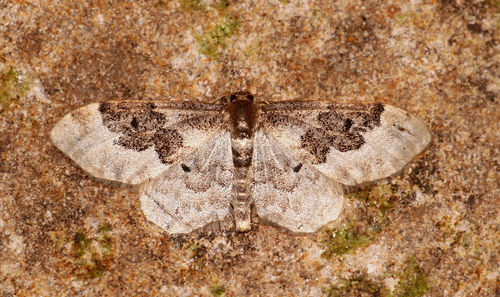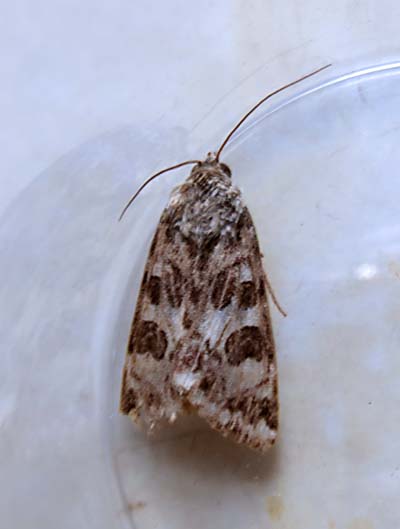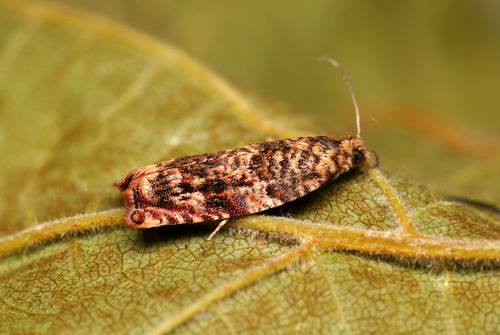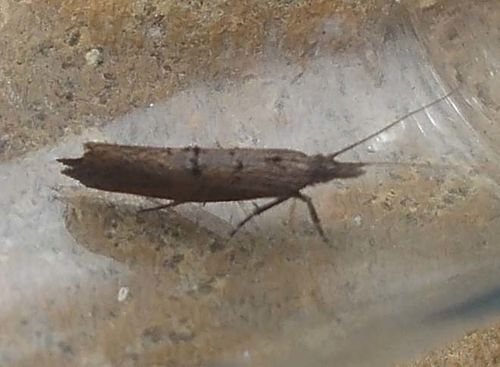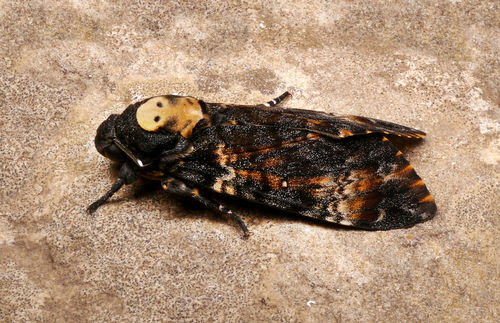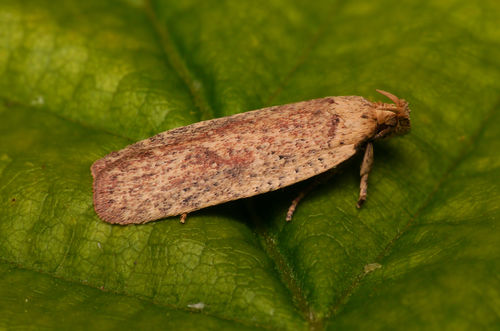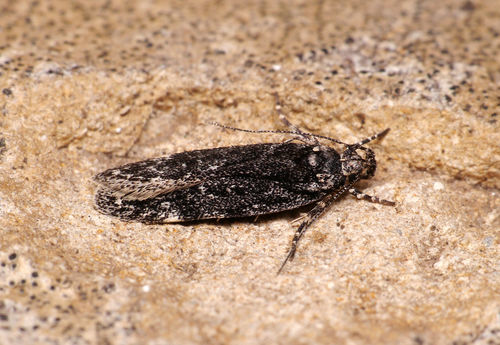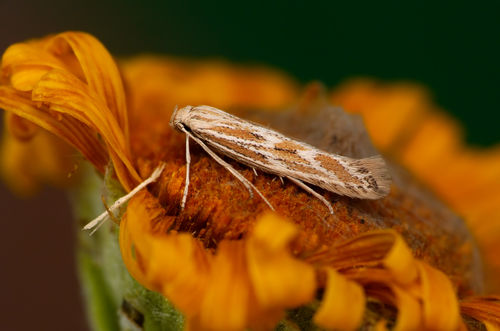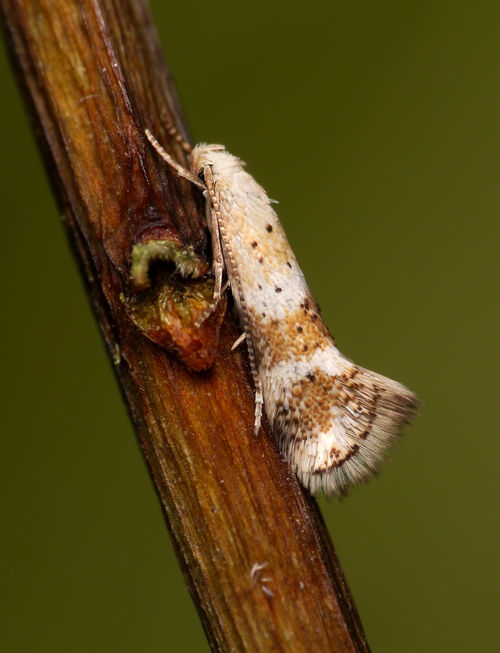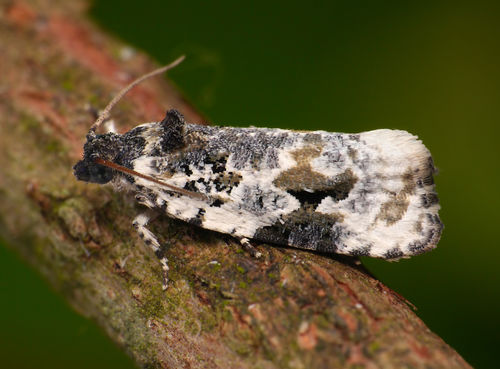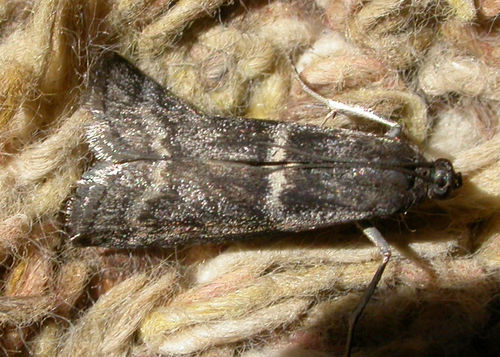Worcestershire Moths Summary 2014
Oliver Wadsworth. oliver.wadsworth@sky.com (database admin)
Tony Simpson. tonysimpson.1945@hotmail.co.uk (county recorder)
The wettest winter on record caused widespread flooding in the county in February 2014 but once the waters subsided, the rest of the years' weather was fairly unremarkable. A reasonable summer ended rather abruptly at the end of August giving way to a long autumn. At time of writing we have received some 17000 records for the VC37 database involving 1020 species. This is somewhat lower, on both counts, than in recent years but there were still some excellent moths seen in the county.
There were four new species recorded in VC37 in 2014.
Least Carpet Idaea rusticata (01) has been spreading north-westwards in the UK, so it was not a surprise when it arrived in Worcestershire in July; being attracted to light traps by Dave & Jane Scott at Astley Burf, by Ian Machin in Bewdley, by Gavin Peplow at Abberton, and in Tony Simpson’s trap at Leigh.
Mike Southall caught a Spotted Clover Protoschinia scutosa (02) at light at Norchard on 29/7/14, a rare migrant with few recent UK records.
Steve Whitehouse caught two new micros at Warndon: Gypsonoma minutana (03) at light in July, whose larva feed between spun leaves of Poplars, and Ypsolopha horridella (04) which he found in his house on 4th August 2914. There have been two records of this species recently in Herefordshire so it seems to be spreading in the West Midlands.
Migrants (table 1).
| Code | Taxon | Vernacular | Totals |
| 0464 | Plutella xylostella | Diamond-back Moth | 194 |
| 1395 | Udea ferrugalis | Rusty-dot Pearl | 15 |
| 1398 | Nomophila noctuella | Rush Veneer | 1 |
| 1716 | Rhodometra sacraria | Vestal | 4 |
| 1973 | Acherontia atropos | Death's Head Hawk Moth | 1 |
| 1984 | Macroglossum stellatarum | Humming-bird Hawk-moth | 15 |
| 2091 | Agrotis ipsilon | Dark Sword-grass | 5 |
| 2119 | Peridroma saucia | Pearly Underwing | 1 |
| 2194 | Hyphilare albipuncta | White Point | 1 |
| 2195 | Mythimna vitellina | Delicate | 1 |
| 2400 | Helicoverpa armigera | Scarce Bordered Straw | 4 |
| 2405 | Schinia scutosa | Spotted Clover | 1 |
| 2441 | Autographa gamma | Silver Y | 66 |
Table 1. Migrant moths recorded in 2014.
With the exception of the Spotted Clover Schinia scutosa mentioned above it was a poor year for migrants. A larva of a Death’s Head Hawk-moth Acherontia atropos was rescued from a cat in Worcester by Val Morris on 3/8/14 and handed in to Worcestershire Wildlife Trust at Smite. It pupated successfully despite a laceration from the cat’s claws and Tony Simpson succeeded in hatching and releasing it, after it was admired by its original captors and many others (05). Another was found at Kemerton just outside the VC37 boundary. Tony trapped The Delicate Mythimna vitellina at Bransford on 29/09/14. Scarce Bordered-Straw Heliothis armigera was seen at Bewdley on 30/10/14 (Ian Machin), Norchard on 11/11/14 (Mike Southall) and Abberton on 31/10/14 (Gavin Peplow). On 30/10/14 Ian also caught a Pearly Underwing Peridroma saucia. Ian Duncan had a White Point Hyphilare albipuncta at Upper Welland on 23/10/14. Gavin Peplow caught a single Sitochroa verticalis at Abberton in July.
All bar one of the 15 Humming-bird Hawk-moths reported were seen in the Malvern Hills area.
Silver Y Autographa gamma were in low numbers throughout the year. 66 recorded in 2014 against 310 in 2013!
Other notable records.
A pair of Privet Hawk-moths Sphinx ligustri were found in copula on a fence post at Windmill Hill WWT reserve on 8/6/14 by a work party which confirms that this species is now breeding in the south of the county. Ian Machin had two Dark Spinach Pelurga comitata at light at Bewdley on 22 & 27/7/14 and Mike Southall another at Norchard also 0n 22/7/14. They also had a Ruddy Carpet Catarhoe rubidata each in July and Peter Holmes had another in Malvern Wells on 19/6/14. There were only three Garden Tigers Arctia caja recorded last year (compared to six in 2013). David Dench attracted a Clouded Magpie Abraxas sylvata and good numbers of Blomer’s Rivulet Dyscoloxia blomeri to light at the new Worcestershire Wildlife Trust reserve, Blackhouse Wood near Suckley. Scarlet Tiger Callimorpha dominula and Small Ranunculus Hecatera dysodea have continued to spread and are now fairly common throughout the county. There have been more widespread records of Silky Wainscot Chilodes maritima.
Tony Simpson rediscovered Agonopterix atomella (06) and Gelechia nigra (07) (single larvae of each at Mill Meadow) breeding them both out and releasing them back on site. The only county record of the latter was one bred from the same site in 1976! It also remains the only modern site for atomella which is on the UK BAP list.
Oliver Wadsworth had Opostega salaciella at Devil’s Spittleful and bred Ptocheuusa paupella (08)from Castlemorton Common. Gavin Peplow caught an Elachista subocellea (09) at Abberton. Martin Skirrow found Depressaria badiella at Carpenter’s Farm, Berrow.
There were a few records of Acrocercops brongniardella, an oak leaf miner, which had not been seen in the county for some years having previously been widespread.
A Wyre Forest Study Group early morning field meeting at the end of May recorded a large number of the beautiful dead wood feeding Schiffermulleria grandis on their post dawn flight at Ribbesford Wood together with a Pseudatemelia flavifrontella, and a number of Alabonia geoffrella and Dascera sulphurella all cavorting in the early morning sunshine.
Becky Lashley of the Worcestershire Biological Records Centre has been running a series of surveys of old orchards in the county. As part of this project Tony Simpson and Oliver Wadsworth got to look at a number of orchards for the rare Mistletoe mining Tortrix Celphya woodiana – another UK BAP species (10). Larvae were found at Green Street, Kempsey Common, Eckington, Croome, and just over the border at Kemerton.
Finally, we were sent a photo by George Davis of an Apomyelois bistriatella from Darkham Wood (11), an extreme outpost of VC37 in the far south-west. The larva of this Pyralid moth feeds in the Cramp-ball fungus Daldinia concentrica usually found on burnt Gorse or dead Ash and Birch. The only previous records were from Hartlebury Common and Devil’s Spittleful.
Format of records.
While the total number of records received was lower than it has been in recent years, the number of recorders has risen and therefore so has our workload. We appreciate all the data we receive and it is certainly not our intention to make life awkward for our recorders but the work needed to input your records to the county database can be greatly reduced if we receive data in certain formats. The easiest format for us is a MapMate sync. If you do not yet use MapMate and would like to, do get in touch and I (Oliver) can explain the system to you.
The next best thing for us is a spreadsheet in MapMate import ready format. If you are using spreadsheets to store your records anyway this should be reasonably easy to achieve. You can download a MapMate import spreadsheet from the website (link at the end of this document or email me and I will send it) that will help with this. It is set up to do some of the work for you by automatically filling in the Latin taxa when given either the vernacular English name or the Bradley number. For columns with constant values you need only enter the value once in the first line.
If you don't get on with spreadsheets and just send an email or text document you can still help make our job easier if you can keep your records in a vertical format. One record per line. Use tabs (or commas – not both) to separate fields. If, for example, you are recording from a constant site like a garden, just give the site name once. Then for each date list the species and numbers separated by a tab. For example:
Back Garden at SO123123
125W MV Skinner Trap
10/10/2015
Feathered Thorn1
Green-brindled Crescent2
Angle Shades3
Snout2
Red-line Quaker3
Large Yellow Underwing1
Brick2
Formatting the text in this way makes it possible for us to extract the data in blocks and change it into the right format for importing quickly.
An example of a dataset that is very difficult to handle might be:
Feathered Thorn 1, Green-brindled Crescent2, Angle Shades 3 10/10/2015
Lunar Underwing 1, Snout 2, Red-line Quaker, 3 15/10/2015
These horizontal lists are impossible to deal with in blocks. We have to enter each record one at a time which is very inefficient.
Finally please remember that in order for us to make the best use of your data we need the following information.
Recorder's Name
Recording site – Address or OS grid reference
Recording method – Trap type, daytime observation etc.
Date
Species name
Stage – adult (implied if light trapping), larval etc.
Number of individuals if counted. Use 0 (zero) to indicate present but not counted
The New Checklist.
At time of writing, MapMate (The recording software we use to store the county database) has just issued a patch to implement changes to Latin names as published by Agassiz, Heckford and Beavan.
At present it is only the butterflies that have been updated – the moths will follow.
For now, recorders can continue to use taxa as they appear on the Mapmate Import Spreadsheet which can be found at the Worcs Moths website. (Link at end of this review.) An updated spreadsheet will be released once the rest of the changes have been made.
Herefordshire and Worcestershire Moth Blog.
Peter Hall has recently set up a Moth orientated Blog for the two counties at:
http://herefordandworcestermoths.blogspot.co.uk/
It is still in its early days but it has great potential as a means of updating each other with our recent sightings, finds and events as well as a place to get ID advice.
Do please sign up and participate.
Many thanks to Peter for his work on this facility.
Once again we would like to thank all those recorders who have contributed records to the county database over the last year. Do please send in any outstanding data from 2014 as soon as possible so we can include it in this years submission to the various national recording schemes we support.
The County List spreadsheet has been updated and is available, along with the rest of the VC37
moth recorders package, from: http://www.temevalleywildlife.com/galleries/WorcestershireMothWebsite.htm. You can also find the MapMate import format Spreadsheet there.
Many thanks to Danny Arnold and the Teme Valley Wildlife group for letting us use some space on their website.
If you need any help with sending in records or identifications do please get in touch with either
myself or county moth recorder Tony Simpson.
Oliver Wadsworth. oliver.wadsworth@sky.com (database admin).
Tony Simpson. tonysimpson.1945@hotmail.co.uk (county recorder).
Images
01. Least Carpet Idaea rusticate 1699. Oliver Wadsworth.
02. Spotted Clover Protoschinia scutosa. Mike Southall
03. Gypsonoma minutana 1171. Oliver Wadsworth.
04. Ypsolopha horridella. Steve Whitehouse.
05. Death's-head Hawk-moth Acherontia atropos 1973. Oliver Wadsworth.
06. Agonopterix atomella 703. Oliver Wadsworth.
07. Gelechia nigra 806. Oliver Wadsworth.
08. Ptocheuusa paupella 748. Oliver Wadsworth.
09. Elachista subocellea 613. Oliver Wadsworth.
10. Celypha woodiana 1066. Oliver Wadsworth.
11. Apomyelosis bistriatella. George Davis
